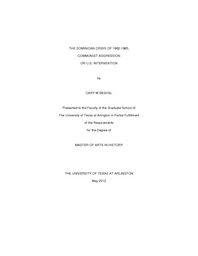
ATTENTION: The works hosted here are being migrated to a new repository that will consolidate resources, improve discoverability, and better show UTA's research impact on the global community. We will update authors as the migration progresses. Please see MavMatrix for more information.
Show simple item record
| dc.contributor.author | Beshel, Cary W. | en_US |
| dc.date.accessioned | 2012-07-25T19:22:47Z | |
| dc.date.available | 2012-07-25T19:22:47Z | |
| dc.date.issued | 2012-07-25 | |
| dc.date.submitted | January 2012 | en_US |
| dc.identifier.other | DISS-11646 | en_US |
| dc.identifier.uri | http://hdl.handle.net/10106/11153 | |
| dc.description.abstract | In this paper I deconstructed the U.S. Invasion of the Dominican Republic in 1965. I also look at the events leading up to the military intervention, such as assassination of Trujillo, the Bosch presidency, and the turbulent period of the military junta. The paper also takes a broader look at the implications of communist expansion and the U.S. response under George Kennan's Domino Theory. I utilized a number of primary documents that have been recently made public to examine the U.S. response to what was seen as a left leaning rebellion within the Dominican Republic. I found that the Cuban Missile Crisis still fresh on the collective minds of President Lyndon Johnson and his State Department, the U.S. wanted to prevent another Caribbean country from going communist. I concluded that while the U.S. response was heavy handed and intrusive it yielded results in that democracy was restored, any communist threat was negated, and the Organization of American States was able to oversee the elections adding legitimacy. | en_US |
| dc.description.sponsorship | Richmond, Douglas W. | en_US |
| dc.language.iso | en | en_US |
| dc.publisher | History | en_US |
| dc.title | The Dominican Crisis Of 1962-1965, Communist Aggression Or U.S. Intervention | en_US |
| dc.type | M.A. | en_US |
| dc.contributor.committeeChair | Richmond, Douglas W. | en_US |
| dc.degree.department | History | en_US |
| dc.degree.discipline | History | en_US |
| dc.degree.grantor | University of Texas at Arlington | en_US |
| dc.degree.level | masters | en_US |
| dc.degree.name | M.A. | en_US |
Files in this item
- Name:
- Beshel_uta_2502M_11646.pdf
- Size:
- 1.026Mb
- Format:
- PDF
This item appears in the following Collection(s)
Show simple item record


